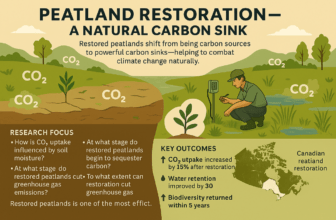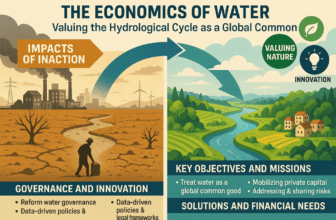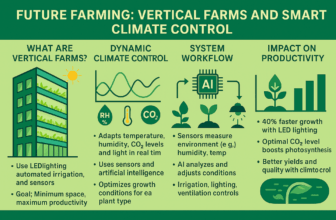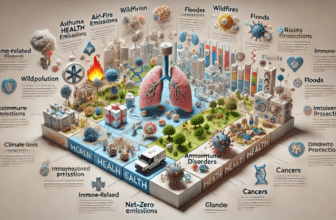The Methane Imperative: Key Objectives, Contradictions, and Investment Analysis

Introduction
“The Methane Imperative,” published in Frontiers in Science in 2024, provides a comprehensive analysis of methane’s role in global climate change and emphasizes the urgent need to reduce methane emissions to meet climate goals. Methane (CH₄), the second most significant greenhouse gas after carbon dioxide (CO₂), contributes significantly to global warming, with a warming potential over 80 times greater than CO₂ over a 20-year period. The document underscores that controlling methane emissions is essential to limit global warming to 1.5°C or 2°C. Methane emissions primarily come from agriculture, fossil fuel extraction, and waste management, making these sectors crucial targets for mitigation strategies. This overview analyzes the key objectives outlined in the document, discusses inherent contradictions among these objectives, and provides estimated investments necessary to achieve them.
Key Objectives
- Halting and Reversing Methane Emission Growth
The document prioritizes the rapid reduction of atmospheric methane concentrations to halt its current growth, which exceeds previous projections. Methane concentrations have been increasing due to activities such as livestock farming, leakage from oil and gas infrastructure, and landfill emissions. To reverse this growth, it is crucial to implement stringent regulations and improve monitoring capabilities to detect and prevent methane leaks.
- Coordinating Methane and CO₂ Mitigation Efforts
The authors emphasize the need for simultaneous and coordinated reductions of methane and CO₂ for effective climate mitigation. Methane reduction has a relatively quick impact on warming potential compared to CO₂, making it a key factor in short-term climate strategies. However, effective coordination between methane and CO₂ mitigation requires a comprehensive understanding of how these gases interact in the atmosphere and affect global temperature targets.
- Enhancing Scientific Understanding
Improving understanding of methane emissions, their sources, and mitigation opportunities is essential. The document advocates for the use of advanced technologies such as satellite monitoring, drones, and data analytics to identify methane emission hotspots more accurately. By enhancing scientific understanding, policymakers can create more targeted and effective emission reduction plans, thereby maximizing the impact of mitigation strategies. Additionally, investing in research on methane’s role in atmospheric chemistry will help refine climate models and projections.
- Optimizing Policy Decisions and Financial Opportunities
The document emphasizes providing policymakers and financiers with data-driven tools to optimize the cost-effectiveness of methane reduction. Effective policy decisions require accurate data and an understanding of the economic implications of various mitigation approaches. Financial opportunities can be optimized by investing in methane-reducing technologies, incentivizing industries to adopt best practices, and creating carbon credit markets that include methane reductions. These financial tools are necessary to drive innovation and encourage both private and public sectors to invest in methane mitigation.
- Increasing Public-Private Collaboration
The goal is to foster cooperation between governments, businesses, and international organizations for effective methane reduction. Public-private partnerships can help overcome barriers to methane mitigation by sharing costs, risks, and expertise. Governments can provide incentives such as subsidies and tax breaks, while private companies can contribute to technological innovations and operational efficiency. Collaboration is particularly important in sectors like agriculture and energy, where methane reduction requires the involvement of multiple stakeholders and coordinated efforts across different scales of operation.
- Reducing Health and Economic Damages
Reducing methane emissions not only addresses climate change but also lowers health risks associated with air pollution and minimizes economic damage. Methane is a precursor to ground-level ozone, which contributes to respiratory and cardiovascular diseases. By reducing methane emissions, we can improve air quality, leading to significant public health benefits and reduced healthcare costs. Furthermore, minimizing methane emissions can reduce economic losses due to extreme weather events exacerbated by climate change, providing broader societal benefits that extend beyond immediate climate goals.
Contradictions in Achieving the Objectives
Achieving these objectives involves several contradictions that may hinder their success:
- Halting Methane Emissions Growth vs. Enhancing Scientific Understanding
- Contradiction: While enhancing scientific understanding is crucial, it could delay mitigation efforts as decision-makers may wait for precise data before taking action. There is a risk that the pursuit of perfect information might slow down the implementation of effective mitigation measures, especially when immediate action is needed to curb rising methane emissions.
- Investment: An estimated $1-3 billion annually for research and technology development could reduce short-term emission reduction effectiveness if resources are diverted away from direct mitigation efforts. Nonetheless, investments in scientific research are critical for long-term success, as they enable the identification of cost-effective and high-impact mitigation opportunities.
- Coordinating Methane and CO₂ Mitigation vs. Optimizing Methane Strategies
- Contradiction: Coordinating methane and CO₂ mitigation may lead to trade-offs where one is prioritized over the other based on political or economic considerations. For instance, political pressures might lead to a focus on CO₂ reductions due to their long-term visibility, potentially neglecting methane’s short-term impact on climate change. This trade-off could undermine the overall effectiveness of climate mitigation strategies.
- Investment: Global CO₂ reduction efforts are projected to cost approximately $3.5 trillion annually until 2050, while methane mitigation may require $50-100 billion annually. If methane mitigation does not receive sufficient attention, the cost of CO₂ reduction could increase by an additional $500 billion per year, as methane’s warming effects contribute to accelerated climate impacts that require more intensive CO₂ reduction efforts.
- Increasing Public-Private Collaboration vs. Optimizing Policy and Finance
- Contradiction: Public-private collaboration may face challenges in regions where the private sector is wary of new regulations and financial commitments. In some industries, the private sector may be reluctant to invest in methane mitigation due to uncertainties about regulatory stability and return on investment. This hesitancy could reduce the public sector’s capacity to implement effective methane reduction measures and achieve ambitious climate targets.
- Investment: Promoting public-private partnerships could require investments of $100-200 billion annually, including subsidies and tax incentives. If the private sector is reluctant to invest, public sector spending could increase by an additional $50-100 billion annually to bridge the gap, potentially straining government budgets and reducing the overall efficiency of climate policies.
- Reducing Health and Economic Damages vs. Halting Methane Growth
- Contradiction: Short-term measures aimed at reducing health and economic damages may require targeted investments that could detract from resources available for long-term climate policies. For example, immediate investments in healthcare infrastructure to mitigate the effects of air pollution may divert funds from methane mitigation projects, limiting the potential for reducing emissions effectively.
- Investment: Investments needed to reduce health-related costs could range from $100-300 billion annually. If resources are primarily directed towards health initiatives, the long-term climate costs could increase by $200-400 billion annually by 2050 due to unmitigated methane emissions and their exacerbation of climate-related impacts.
- Coordinating Methane and CO₂ Mitigation vs. Increasing Public-Private Collaboration
- Contradiction: The private sector may prefer short-term investments that yield quick returns, whereas coordinating methane and CO₂ mitigation requires a long-term vision and sustained investment. This divergence in priorities could create pressure to reduce public sector spending on long-term projects, potentially undermining the coordinated reduction of CO₂ and methane.
- Investment: Coordinated methane and CO₂ mitigation efforts require $100-200 billion annually worldwide. If the private sector focuses on short-term profits, public sector costs might rise by an additional $50-100 billion annually to maintain the necessary long-term vision. This could lead to an imbalance in the allocation of resources, making it challenging to achieve comprehensive climate mitigation.
Conclusion
“The Methane Imperative” presents ambitious goals for reducing methane and CO₂ emissions, but achieving them requires balancing conflicting priorities and navigating inherent contradictions. Addressing these contradictions effectively will depend not only on financial resources but also on political will, international cooperation, and a shared commitment to the long-term benefits of climate action. The estimated annual investment needed to meet global methane and CO₂ reduction targets ranges from $500 billion to $1 trillion. These expenditures must be allocated strategically to maximize benefits, minimize trade-offs, and ensure effective climate mitigation. Ultimately, the successful attainment of these goals will rely on a coordinated effort that leverages scientific advancements, fosters public-private partnerships and integrates health and economic considerations into climate policies. A sustainable and climate-friendly future can be realized only through comprehensive, well-coordinated actions that address both the immediate and long-term challenges posed by methane and CO₂ emissions.









